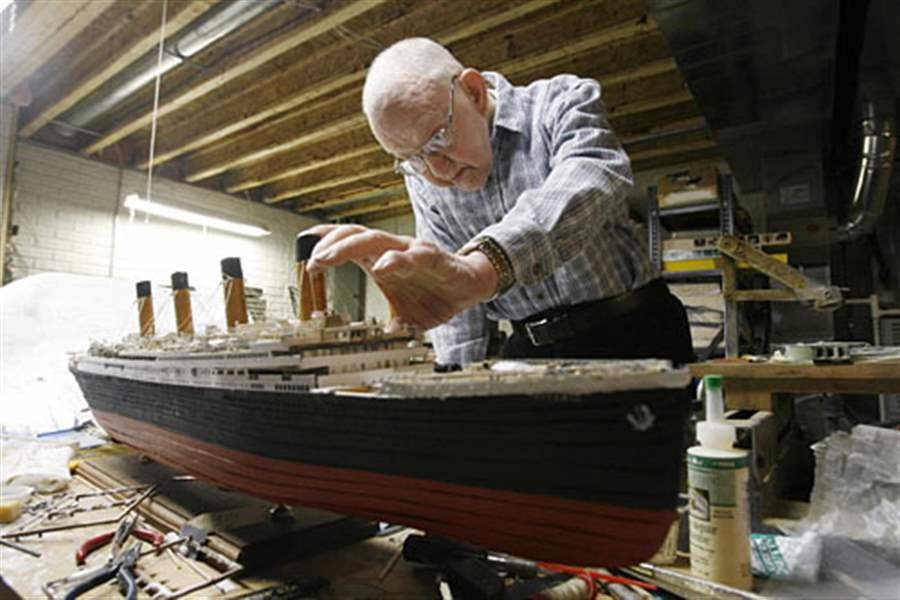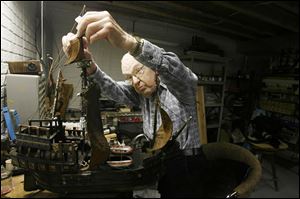
The master of a miniature fleet
1/20/2007
Jacques Rietzke, 82, a master model shipbuilder, works on his model of the Titanic. He says it is about 90 percent complete.

Jacques Rietzke, 82, a master model shipbuilder, works on his model of the Titanic. He says it is about 90 percent complete.
Jacques Rietzke doesn t get around so well anymore, but he can leave his walker behind and travel through time and place aboard the magnificent model ships that are berthed throughout his suburban Toledo home.
There s the Cutty Sark, the famous 19th century clipper ship.
The Niagara, a 20-gun brig that made history in the Battle of Lake Erie in 1813. The lifeboat from the HMS Bounty, in which Capt. William Bligh was cast adrift after
his crew mutinied in 1789. The Confederate privateer Jefferson Davis, which sank in 1861.
All those ships and more took detailed and exquisite shape in the hands of Mr. Rietzke, 82, a master model shipbuilder who found his hobby more than 70 years ago when he saved Post Toasties cereal box tops and mailed them in for a simple balsa-wood model of an airplane.
That hobby has been feeding his soul ever since.
I built my first model airplane when I was about 10, Mr. Rietzke said. Thinking way back, he estimated he had to polish off at least 25 boxes of the cereal to earn the model. I played with it as long as it remained in playable condition which wasn t very long, he said.
What remained after the plane took its last nosedive was the sense of accomplishment he had discovered in putting it together. I just got fascinated with building something, he said. Mr. Rietzke graduated to motorized model airplanes,
figuring things out on his own and with the help of books.
Then models gave way to reality: World War II. At 18, Mr. Rietzke enlisted in the Army and served three years in the South Pacific.
When he returned, he got married and started working as a probation officer in juvenile court in Indianapolis. And he returned to building models radio-controlled airplanes.

Mr. Rietzke also repairs ships brought to him by others, including this Spanish galleon.
Mr. Rietzke kept at it, somehow finding the time while being a father to four children, earning bachelor s and master s degrees in sociology from the University of Toledo after moving back to northwest Ohio, and at one point teaching classes in introductory sociology and the history of organized crime at Bowling Green tate University. He also worked for the Lucas County adult probation department.
Just as World War II interrupted his hobby at 18, another battle a personal one interrupted him in his 30s. A series of health problems led to hospitalizations, tests, and eventually a diagnosis of multiple sclerosis. I lost my coordination, Mr. Rietzke said. And you don t fly radio-controlled models without proper coordination.
That s when he began building boats, a decision that didn t come easily. I m sure I was pretty heartbroken when I had to give up the airplanes, Mr. Rietzke said.
But, I knew I had to fill in with something if I was to stay in the hobby.
Disability forced him to retire when he was 54.
He guesses he s built 50 ships over the years, including radiocontrolled scale models of a tug and a fishing boat he used to take out for spins on a pond in South Toledo, as well as ships that are purely works of art, for display only. Many of the ships he s made are in homes in northwest Ohio and southeast Michigan, he said.
He donated others for display on the Willis B. Boyer Museum Ship at International Park in downtown Toledo: the Edmund Fitzgerald lake freighter which sank in a gale on Lake Superior in 1975, and the Toledo-built David Dows. It was the only five-masted ship that ever sailed the Great Lakes, Mr. Rietzke said.
He s sorry he let some of his ships go, among them a model of the Amerigo Vespucci, an Italian ship that s used to train naval cadets. I regret it. It was a beautiful ship, he recalled.
It goes without saying that patience is required for this hobby.
You have to figure when you lay the keel for one of these things, you better allow yourself a year for it, he said. You just can t rush.
He works from scratch and from kits, with tools large and small in his cluttered basement workroom. It s not unusual for me to be working with a pair of tweezers in each hand, he said.
While others might be agitated by the thousands of pieces and months of precision work, it completely calms him down, said his wife, Phyllis, who d rather be doing counted cross-stitch and jigsaw puzzles.
Much of Mr. Rietzke s time now is taken up with repairs on model ships that people bring to him, such as the Spanish galleon that s perched on the turntable on his workbench waiting for new rigging and sails.
On a table nearby, there s a scale model of the Titanic that Mr. Rietzke has almost finished and is itching to get back to. And just steps away is the Queen Mary 2, still in pieces in its huge box.
It s not the hobby for the majority of people, he acknowledged. It s one of those things. You have it or you don t have it. I ve been able to stick with this.
Contact Ann Weber at:
aweber@theblade.com
or 419-724-6126.